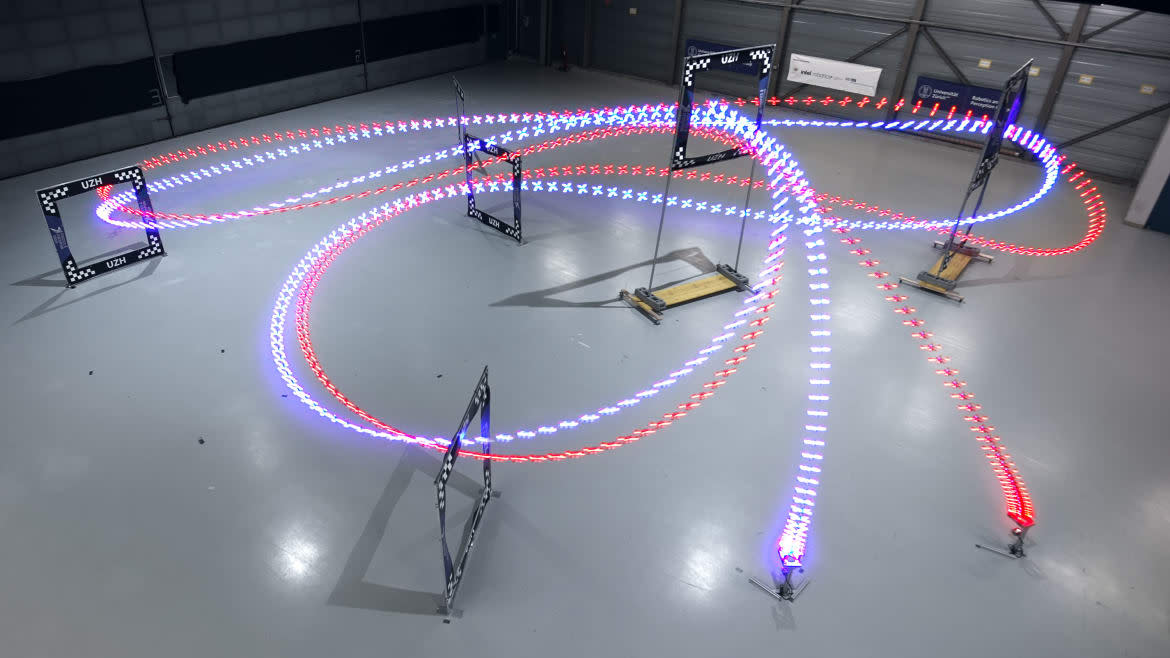This AI-Powered Drone Demolished Human Pilots in a Race

While the past few months have shown us that there’s still a lot that AI can’t do that humans can (like write news articles, for example), there are a few areas where the bots are starting to gain an edge on their flesh-and-blood counterparts.
Case in point: A team of engineers at the University of Zurich in Switzerland published a study Tuesday in the journal Nature where they developed an AI dubbed Swift that can fly drones capable of beating human pilots in head-to-head races. The hybrid learning system in which the bot was trained has the potential to be used in autonomous technologies like self-driving cars, personal robotics, and even autonomous planes.
“Our result marks the first time that a robot powered by AI has beaten a human champion in a real physical sport designed for and by humans," lead author Elia Kaufmann, an autonomy engineer at the University of Zurich, told The Daily Beast in an email. "This result is a milestone for robotics, machine intelligence, and beyond, which may inspire the deployment of hybrid learning-based solutions in other physical systems, such as autonomous vehicles, aircraft, and personal robots, across a broad range of applications."
The world of drone racing has blown up since its humble beginnings in 2011, when a group of German hobbyists held the first official drone race. While there have been efforts to develop a drone-flying AI in the past, none have been able to defeat human pilots—until now.
The team behind Swift designed it using deep reinforcement learning (DRL), which is a type of machine learning for AI that teaches it how to behave in specific situations through trial and error. Over time, it learns how to obtain the correct outcome through rewards (in this case, that’s winning the race). The DRL is also conducted in simulations utilizing real-world data to mimic physical environments.
"Swift uses onboard sensors, therefore it is fully autonomous," Kaufmann explained. "You don’t need to first instrument the environment with external sensors; instead, just turn on the robot and fly!"
For the study, the race track was designed by a professional drone-racing pilot. Swift competed against three human drone-racing champions who were each given a week of practice on the track. In a series of head-to-head races, the AI was able to defeat the humans in 15 out of 25 races. It also managed to clock the fastest recorded race time on the track—and was even half a second over the best human pilot time.
"The findings of this project can be leveraged in diverse domains that require an autonomous robot to perform a task in a timely manner," Kaufmann said. "One potential application would be autonomous infrastructure inspection, autonomous warehouse management, or search and rescue scenarios."
Does this mean AI-fueled drones will soon take over our roadways and skies in a Terminator-esque hellscape? Not quite. There’s still quite a way to go, due to the limitations of the Swift system.
You Can Control These Flying Racing Drones With Your Brain
For one, if a mistake does occur—if the Swift drone hits a barrier or flies into the ground—it’ll struggle much more than a human pilot, who can right the drone and fly back up. It also wouldn’t react well to changes in the physical environment like weather—something humans can excel at.
“The real world is also much more unpredictable than a virtual one,” Guido de Croon, a robotics researcher at Delft University of Technology in the Netherlands who wasn’t involved in the study, said in an accompanying commentary.
He added, “[Although] the flight behaviors of the drones typically used in racing have been modeled extensively, predictions still fall short of reality, especially at high speeds, during agile maneuvers or in the presence of external disturbances.”
However, the model still offers a new and potentially groundbreaking approach for autonomous robotics. At the very least, it might help Elon Musk finally figure out how to make a self-driving car that doesn’t try to kill its driver.
Get the Daily Beast's biggest scoops and scandals delivered right to your inbox. Sign up now.
Stay informed and gain unlimited access to the Daily Beast's unmatched reporting. Subscribe now.

